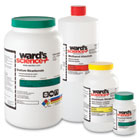Chemical Safety in Your Lab: Do’s and Don’ts

Middle & High School
Managing a lab full of chemicals can be daunting, especially when it comes to ensuring safety and making cost-effective decisions. This guide covers the keys to managing chemicals safely and efficiently in the classroom.
You can also check out Ward’s Science Lab Resource Manual, the ultimate guide for managing chemicals in the classroom. Following best practices guidelines will help you and your students enjoy a stimulating, educational, and safe classroom experience.
The Do's and Don'ts of chemical safety in the classroom
Our quick Do’s and Don’ts list offers practical advice on using chemicals safely to prevent accidents.
DO: Minimize RisksUse alternatives to hazardous chemicals when possible, providing the same learning opportunities in a safer classroom environment. |
|
 |
DO be aware of recommended substitutions for common hazardous chemicals. Example: A high school chemistry teacher downloaded the Safer Chemical Substitutions guide before purchasing chemicals to stock her lab. She chooses an aqueous version of the flame test lab instead of a version that uses methanol. |
 |
DO conduct regular reviews of your chemical inventory to identify safer alternatives. Example: A middle school science teacher routinely reviews his chemical inventory and compares it to the latest safety guidelines. Before starting a new unit, he discovers that vinegar (acetic acid) is a safer, non-toxic alternative to hydrochloric acid for an acid-base reaction demonstration and updates his lesson plan accordingly. |
DON'T: Compromise on Safety for CostWhen managing chemicals in the science classroom, prioritizing safety over short-term cost savings is essential for accurate demonstrations and student safety. |
|
 |
DON’T use outdated chemicals to save money. This can compromise the accuracy of demonstrations and, more importantly, pose serious safety risks to students and educators. Always opt for up-to-date materials to ensure educational integrity and safety in the science classroom. Example: A chemistry teacher decides to use some old chemicals she found in the back of the storage room for a demonstration. These chemicals had been sitting there for years, well past their recommended shelf life. Unbeknownst to her, the ethyl ether had formed dangerous, explosive peroxides. |
 |
DON'T neglect to use proper personal protective equipment (PPE) to cut costs. Skimping on gloves, goggles, or lab coats can result in accidents and injuries, compromising student safety and the integrity of your experiments. Always ensure that adequate PPE is available and used correctly. Example: A high school chemistry teacher tries to save money by not ordering new lab goggles for her students, thinking the old ones are "good enough.” |
DON'T: Over-Purchase ChemicalsBuy only what you need to avoid the headaches of chemical disposal. By avoiding bulk purchases and carefully managing legacy chemicals, school labs can maintain safer environments, ensure compliance with regulatory standards, protect the environment, and optimize their chemical budget. Smart purchasing practices ensure you have enough for demonstrations without excess that will expire and require future disposal. |
|
 |
DON'T buy chemicals in bulk if you don’t expect frequent use to avoid issues with storage and disposal. Example: A school ordered a large quantity of iodine solution, which expired before being used, leading to wasteful disposal. |
 |
DON'T inherit or maintain legacy chemicals without proper assessment; outdated or deteriorating chemicals can pose significant safety risks. Example: A teacher found a bottle of benzene with a cracked lid in the chemical storeroom and did not dispose of it properly, which posed a serious health risk. |
DO: Properly Store and Manage ChemicalsProper chemical management in the lab is crucial to ensure safety and regulatory compliance. |
|
 |
DO ensure that all chemicals, regardless of grade, are stored appropriately to prevent deterioration and safety hazards. Example: The lab manager relocated hygroscopic substances to a climate-controlled cabinet to prevent moisture absorption |
 |
DO label all solutions you prepare with contents, concentrations, and dates. Example: A veteran chemistry teacher always labels every solution she prepares with the contents, concentration, and date of preparation. This practice ensures that she and her students can easily identify each solution and understand its strength and age, thereby maintaining a safe and organized lab environment. |
 |
DO keep accurate and up-to-date Safety Data Sheets (SDSs) records in an organized binder for easy access during inspections or emergencies. Example: During a routine inspection, a teacher quickly provided the SDS for acetic acid to the fire marshal, demonstrating compliance with safety regulations. |
 |
DO store chemicals according to compatibility guidelines to prevent dangerous reactions, spills, or explosions. Always follow proper storage protocols to ensure a safe learning environment. Example: A chemistry teacher organizes his storage area by chemical compatibility. Despite running low on space, he avoids placing hydrochloric acid beside ammonia, maintaining a safe and compliant storage system. |
Hint: Ward’s Chemical Inventory Management System (CIMS) simplifies chemical storage with a user-friendly system that maintains the highest safety standards.
• Simplified Storage: Just five easy categories to streamline chemical storage and minimize errors.
• Universal Access: Manage your inventory from any web browser; details are accessible during emergencies.
• Detailed Tracking: Trace chemicals by building, room, and cabinet locations.
• Integration: Compatible with Ward’s color-coded chemical storage system.
• Flexible Management: Add, modify, or delete inventory items; view detailed chemical information online.
• Includes SDS, storage codes, and more.
DON'T: Neglect Regular Safety ChecksMaintaining a safe lab involves vigilant oversight and prompt action; take the proper precautions. |
|
 |
DON'T overlook the importance of regular safety audits in your lab to check the integrity of chemical containers and labels. Example: Ignoring regular safety checks, a teacher only discovered an unlabeled and potentially hazardous substance during an unexpected visit from the fire marshal, leading to a safety violation notice. |
 |
DON'T delay disposing of chemicals that have surpassed their shelf life or show signs of degradation. Example: A lab technician overlooked the protocol for periodic inspection, leaving a bottle of ether on the shelf too long. He did not notice that nitric acid had caused the cap on its bottle to crumble, and vapor corroded the labels of all the bottles in the acid cabinet, all posing a significant risk to the lab's safety. |
DO: Educate and InformImplementing chemical management best practices enhances safety and optimizes efficiency in your classroom. |
|
 |
DO use this knowledge to guide your students on the importance of chemical safety and proper handling techniques. Example: A chemistry teacher used the student safety contract she downloaded from 9 Ways to Reinforce Lab Safety during the first lab-safety orientation. |
 |
DO use comprehensive resources to plan your learning space. Example: Ward’s Science offers this Planning Your Learning Space guide to |
 |
DO advocate for smaller, manageable quantities of chemicals and a chemical disposal budget to promote a safer, more efficient lab environment. A gram of prevention is worth a kilogram of cure. Example: To minimize risk and waste, a teacher ordered 100 mL bottles of sulfuric acid instead of the available 1-liter bottles for the academic year. Her district appropriated the funds to dispose of legacy chemicals from the previous instructor properly. |
Following these Dos and Don'ts will boost demonstration quality and student safety in your classroom.
Did You Know? Ward’s Science, chemistry, and safety experts monitor the latest safety requirements and deliver the tools and support you need to keep your lab compliant and students safe. Check out our extensive selection of chemicals, each accompanied by GHS-compliant chemical labels and SDS for your safety and convenience.
We hope this guide helps you implement chemical management best practices in your classroom lab. Remember to bookmark our Safety Resources page for quick and easy access anytime. Plus, we're here to answer your most challenging questions and provide personalized support for every chemical, from our science labs to yours. Contact Sales support here.
**Disclaimer: While this document outlines general guidelines for chemical disposal in educational settings, educators must consult and comply with local and state regulations. Please confirm these guidelines with your local environmental and waste management authorities to ensure full compliance and safety.
Recommended Products
[StartProductBlock]

Chemicals for Science Education
75% more chemicals to choose from than the leading educational supplier, plus over 300,000 more research and clinical-grade chemicals available by request. All the chemicals you need to outfit your entire chemistry lab.
[EndProductBlock]
[StartProductBlock]

Gloves
An additional layer of defense for individuals handling hazardous materials and protecting sensitive substances from being cross-contaminated.
[EndProductBlock]
